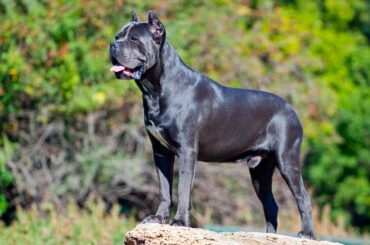Newfoundlanders, who are native to the Canadian province of Newfoundland, Newfoundland Dogs have a natural affinity for water. Some breed historians believe European fishermen mixed their own dogs with the Newfoundland’s ancestors, possibly a Great Pyrenees.
In Newfoundland, the breed was bred and employed as a working dog for fishermen. Fishermen and explorers from Ireland and England visited the Grand Banks of Newfoundland in the early 1880s, where they recorded two varieties of working dogs.
One was a giant water dog with a longish coat, while the other was a medium-sized water dog with a smooth coat. The Greater Newfoundland was the heavier breed. The Lesser Newfoundland, sometimes known as the St. John’s water dog, was a smaller breed.
According to legend, the breed is the result of a crossbreeding of numerous European breeds in the 15th and 16th centuries, including Pyrenean Sheep Dogs, Mastiffs, and Portuguese Water Dogs. The breed was nearly extinct in the 1780s due to government-imposed regulations requiring Canadian families to pay taxes on the one dog they were allowed to retain.

Sir Edwin Landseer (1802-1873), who liked to feature Newfoundland in his paintings, was one person who contributed to the island’s comeback. In his honor, the white and black breed strain was dubbed Landseer. The first Newfoundland was presented in England in 1860. The American Kennel Club originally recognized the breed in 1879, and the first American Newfoundland champion was named in 1883.
Table of Contents
Body Characteristics of the Newfoundland Dogs
- Newfoundland Dogs are big-boned, powerful dogs with large heads that sit near or above an adult’s hip for comfortable caressing.
- The majority of their height comes from the rise of their deep chests and broad backs from stout-but-powerful legs, which average 26–28 inches at the withers, has deep, drooping eyes, usually dark brown, situated atop a deep, wide nose.
- A loving expression begs you to brush her long, velvety ears on a regular basis.
Males weigh 65–80 kg (143–176 lb), while females weigh 55–65 kg (121–143 lb). They can reach a shoulder height of 56–76 cm (22–30 in). Newfoundland’s colors include black, brown, grey, and white-and-black. Other colors are possible, but they aren’t considered more important or unusual. The double coat of this breed is flat and water-resistant. The undercoat is soft and dense, and the outside coat is coarse and lengthy.
Behavior of the Newfoundland Dogs
The breed is noted for its power as well as its calm and gentle demeanor. They are extremely loyal, have a gentle temperament, and make excellent working dogs. This is why this breed is referred to as “the gentle giant.” They are exceptional with youngsters. Newfoundlands are natural worker dogs and people pleasers. They rely on you to tell them what has to be done and like helping others.

The sweetness of temperament is the trademark of Newfoundland; this is the most essential single quality of the breed, according to the American breed standard. In general, Newfoundland is fine with other animals, although its size might be problematic if it is not well trained.
Training the Newfoundland Dogs
Because the breed grows swiftly, training should begin early. Because he is generally eager to please, training him is rather simple. With Newfoundlands, leash training is a necessity. Begin training and socialization as soon as you bring your puppy home. Positive orders and appropriate signals reinforce your dog’s good behavior.
Caring for the Newfoundland Dogs
He has a strong work ethic and requires physical and mental stimulation. Swimming is an excellent type of exercise for Newfoundland puppies since it allows them to train their muscles without risking joint injury. They require the moderate exercise of up to 30 minutes per day and prefer to walk with their owners rather than run.

A lot of grooming is required for this dog breed. There’s her double-hair coat, which benefits from regular brushing, and there’s also substantial shedding approximately twice a year to worry with. She’ll shed largely in the fall and spring, and will need to be brushed daily to keep it under control.
Newfoundland Dogs – Health
Newfoundland is related to a number of health issues. Hip dysplasia, elbow dysplasia, and cystinuria are all common in this breed. Subvalvular aortic stenosis is another hereditary issue (SAS). This breed, on the other hand, can live up to 15 years.
RECOMMENDED ARTICLES
- Mastiff Dog Breed – 8 Exclusive Body Characteristics, Behaviour and Health
- Leonberger Dog – 4 Comprehensive Body Characteristics, Behaviour And Health
- Kuvasz Dog – Characteristics, Behaviour Caring And Health
- Heatstroke In Dogs- Causes, Symptoms, And Treatment
- Komondor Dog – 7 Comprehensive Body Characteristics, Behaviour, Caring And Health
If you like please share it. Sharing is usually caring.




